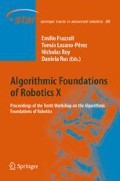Abstract
This paper formulates a new Minimum Constraint Removal (MCR) motion planning problem in which the objective is to remove the fewest geometric constraints necessary to connect a start and goal state with a free path. I present a probabilistic roadmap motion planner for MCR in continuous configuration spaces. The planner operates by constructing increasingly refined roadmaps, and efficiently solves discrete MCR problems on these networks. A number of new theoretical results are given for discrete MCR, including a proof that it is NP-hard by reduction from SET-COVER, and I describe two search algorithms that perform well in practice. The motion planner is proven to produce the optimal MCR with probability approaching 1 as more time is spent, and its convergence rate is improved with various efficient sampling strategies. The planner is demonstrated on three example applications: generating human-interpretable excuses for failure, motion planning under uncertainty, and rearranging movable obstacles.
Access this chapter
Tax calculation will be finalised at checkout
Purchases are for personal use only
Preview
Unable to display preview. Download preview PDF.
References
Basch, J., Guibas, L., Hsu, D., Nguyen, A.T.: Disconnection proofs for motion planning. In: IEEE Int. Conf. Rob. Aut., Seoul, Korea, pp. 1765–1772 (2001)
Bretl, T., Lall, S., Latombe, J.-C., Rock, S.: Multi-step motion planning for free-climbing robots. In: Workshop on the Algorithmic Foundations of Robotics, Zeist, Netherlands (2004)
Dogar, M.R., Srinivasa, S.S.: A framework for push-grasping in clutter. In: Robotics: Science and Systems (2011)
Frigioni, D., Marchetti-Spaccamela, A., Nanni, U.: Fully dynamic algorithms for maintaining shortest paths trees. Journal of Algorithms 34(2), 251–281 (2000)
Göbelbecker, M., Keller, T., Eyerich, P., Brenner, M., Nebel, B.: Coming up with good excuses: What to do when no plan can be found. In: Int. Conf. on Automated Planning and Scheduling (2010)
Hsu, D., Latombe, J.-C., Motwani, R.: Path planning in expansive configuration spaces. In: IEEE Int. Conf. Rob. Aut., pp. 2219–2226 (1997)
Huang, Y., Gupta, K.: Collision-probability constrained prm for a manipulator with base pose uncertainty. In: IEEE/RSJ Int. Conf. Intel. Rob. Sys., pp. 1426–1432 (2009)
Karaman, S., Frazzoli, E.: Incremental sampling-based algorithms for optimal motion planning. In: Robotics: Science and Systems (RSS), Zaragoza, Spain (2010)
LaValle, S.M., Kuffner Jr., J.J.: Randomized kinodynamic planning. Int. J. Rob. Res. 20(5), 379–400 (2001)
Lund, C., Yannakakis, M.: On the hardness of approximating minimization problems. J. of the ACM 41(5), 960–981 (1994)
McCarthy, Z., Bretl, T., Hutchinson, S.: Proving path non-existence using sampling and alpha shapes. In: IEEE Int. Conf. Rob. Aut. (2012)
Prosser, P.: An empirical study of phase transitions in binary constraint satisfaction problems. Artificial Intelligence 81(1-2), 81–109 (1996)
Reif, J.H.: Complexity of the mover’s problem and generalizations. In: 20th Annual IEEE Symposium on Foundations of Computer Science, San Juan, Puerto Rico, pp. 421–427 (1979)
Stilman, M., Kuffner, J.: Navigation among movable obstacles: Real-time reasoning in complex environments. International Journal of Humanoid Robotics 2(4) (December 2005)
Vazirani, V.V.: Approximation Algorithms. Springer (2001)
Zhang, L., Kim, Y., Manocha, D.: A simple path non-existence algorithm using c-obstacle query. In: Akella, S., Amato, N., Huang, W., Mishra, B. (eds.) Algorithmic Foundation of Robotics VII. STAR, vol. 47, pp. 269–284. Springer, Heidelberg (2008)
Author information
Authors and Affiliations
Corresponding author
Editor information
Editors and Affiliations
Rights and permissions
Copyright information
© 2013 Springer-Verlag Berlin Heidelberg
About this paper
Cite this paper
Hauser, K. (2013). The Minimum Constraint Removal Problem with Three Robotics Applications. In: Frazzoli, E., Lozano-Perez, T., Roy, N., Rus, D. (eds) Algorithmic Foundations of Robotics X. Springer Tracts in Advanced Robotics, vol 86. Springer, Berlin, Heidelberg. https://doi.org/10.1007/978-3-642-36279-8_1
Download citation
DOI: https://doi.org/10.1007/978-3-642-36279-8_1
Publisher Name: Springer, Berlin, Heidelberg
Print ISBN: 978-3-642-36278-1
Online ISBN: 978-3-642-36279-8
eBook Packages: EngineeringEngineering (R0)

